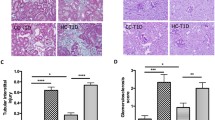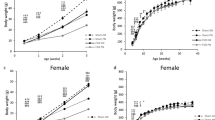Abstract
We used uncontrolled maternal diabetes as a model to provoke fetal growth restriction in the female in the first generation (F1) and to evaluate reproductive outcomes and the possible changes in metabolic systems during pregnancy, as well as the repercussions at birth in the second generation (F2). For this, nondiabetic and streptozotocin-induced severely diabetic Sprague-Dawley rats were mated to obtain female pups (F1), which were classified as adequate (AGA) or small (SGA) for gestational weight. Afterward, we composed two groups: F1 AGA from nondiabetic dams (Control) and F1 SGA from severely diabetic dams (Restricted) (n minimum = 10 animals/groups). At adulthood, these rats were submitted to the oral glucose tolerance test, mated, and at day 17 of pregnancy, blood samples were collected to determine glucose and insulin levels for assessment of insulin resistance. At the end of the pregnancy, the blood and liver samples were collected to evaluate redox status markers, and reproductive, fetal, and placental outcomes were analyzed. Maternal diabetes was responsible for increased SGA rates and a lower percentage of AGA fetuses (F1 generation). The restricted female pups from severely diabetic dams presented rapid neonatal catch-up growth, glucose intolerance, and insulin resistance status before and during pregnancy. At term pregnancy of F1 generation, oxidative stress status was observed in the maternal liver and blood samples. In addition, their offspring (F2 generation) had lower fetal weight and placental efficiency, regardless of gender, which caused fetal growth restriction and confirmed the fetal programming influence.





Similar content being viewed by others
Data Availability
Data supporting findings are presented within the manuscript.
References
American Diabetes Association (ADA). Classification and diagnosis of diabetes: standards of medical care in diabetes–2022. Diabetes Care. 2022;45:S17–38. https://doi.org/10.2337/dc22-S002.
International Diabetes Federation. IDF Diabetes Atlas. 10th ed. Brussels: International Diabetes Federation; 2021.
Lowe WL, Scholtens DM, Kuang A, Linder B, Lawrence JM, Lebenthal Y, et al. Hyperglycemia and adverse pregnancy outcome follow-up study (HAPO FUS): maternal gestational diabetes and childhood glucose metabolism. Diabetes Care. 2019;42:372–80. https://doi.org/10.2337/dc18-1646.
Melamed N, Baschat A, Yinon Y, Athanasiadis A, Mecacci F, Figueras F, et al. FIGO (International Federation of Gynecology and obstetrics) initiative on fetal growth: best practice advice for screening, diagnosis, and management of fetal growth restriction. Int J Gynaecol Obstet. 2021;152:3–57. https://doi.org/10.1002/ijgo.13522.
Chew LC, Verma RP. Fetal growth restriction. In: StatPearls. StatPearls Publishing: Treasure Island (FL); 2021. p. 1–16.
Barker DJP, Osmond C, Golding J, Kuh D, Wadsworth MEJ. Growth in utero, blood pressure in childhood and adult life, and mortality from cardiovascular disease. BMJ. 1989;298:564–7. https://doi.org/10.1136/bmj.298.6673.564.
Hales CN, Barker DJ. The thrifty phenotype hypothesis. Br Med Bull. 2001;60:5–20. https://doi.org/10.1093/bmb/60.1.5.
Gluckman PD, Hanson MA, Beedle AS. Early life events and their consequences for later disease: a life history and evolutionary perspective. Am J Hum Biol. 2007;19:1–19. https://doi.org/10.1002/ajhb.20590.
Beauchamp B, Harper ME. In utero undernutrition programs skeletal and cardiac muscle metabolism. Front Physiol. 2016;6:401. https://doi.org/10.3389/fphys.2015.00401.
Simmons RA, Templeton LJ, Gertz SJ. Intrauterine growth retardation leads to the development of type 2 diabetes in the rat. Diabetes. 2001;50:2279–86. https://doi.org/10.2337/diabetes.50.10.2279.
Zambrano E, Martínez-Samayoa PM, Bautista CJ, Deás M, Guillén L, Rodríguez-González GL, et al. Sex differences in transgenerational alterations of growth and metabolism in progeny (F2) of female offspring (F1) of rats fed a low protein diet during pregnancy and lactation. J Physiol. 2005;566:225–36. https://doi.org/10.1113/jphysiol.2005.086462.
Cheong JN, Wlodek ME, Moritz KM, Cuffe JS. Programming of maternal and offspring disease: impact of growth restriction, fetal sex and transmission across generations. J Physiol. 2016;594:4727–40. https://doi.org/10.1113/JP271745.
Holemans K, Aerts L, Van Assche FA. Fetal growth restriction and consequences for the offspring in animal models. J Soc Gynecol Investig. 2003;10:392–9. https://doi.org/10.1016/s1071-55760300134-5.
Lopez-Tello J, Arias-Alvarez M, Gonzalez-Bulnes A, Sferuzzi-Perri NA. Models of intrauterine growth restriction and fetal programming in rabbits. Mol Reprod Dev. 2019;86:1781–09. https://doi.org/10.1002/mrd.23271.
Vuguin P. Animal models for assessing the consequences of intrauterine growth restriction on subsequent glucose metabolism of the offspring: a review. J Matern Fetal Neonatal Med. 2002;11:254–7. https://doi.org/10.1080/jmf.11.4.254.257.
Corvino SB, Netto AO, Sinzato YK, Campos KE, Calderon IM, Rudge MV, et al. Intrauterine growth restricted rats exercised at pregnancy. Reprod Sci. 2015;22:991–9. https://doi.org/10.1177/1933719115570905.
Parrettini S, Caroli A, Torlone E. Nutrition and metabolic adaptations in physiological and complicated pregnancy: focus on obesity and gestational diabetes. Front Endocrinol (Lausanne). 2020;11:611929. https://doi.org/10.3389/fendo.2020.611929.
Duhig K, Chappell LC, Shennan AH. Oxidative stress in pregnancy and reproduction. Obstet Med. 2016;9:113–6. https://doi.org/10.1177/1753495x16648495.
Sinzato YK, Klöppel E, Miranda CA, Paula VG, Alves LF, Nascimento LLS, et al. Comparison of streptozotocin-induced diabetes at different moments of the life of female rats for translational studies. Lab Anim Res. 2021;55:329–40. https://doi.org/10.1177/00236772211001895.
Beery AK, Francis DD. Adaptive significance of natural variations in maternal care in rats: a translational perspective. Neurosci Biobehav Rev. 2011;35:1552–61. https://doi.org/10.1016/j.neubiorev.2011.03.012.
Paula VG, Sinzato YK, Moraes-Souza RQ, Soares TS, Souza FQG, Karki B, Andrade Paes AM, et al. Metabolic changes in female rats exposed to intrauterine hyperglycemia and post-weaning consumption of high-fat diet. Biol Reprod. 2022;106:200–12. https://doi.org/10.1093/biolre/ioab195.
Tai MA. Mathematical model for the determination of total area under glucose tolerance and other metabolic curves. Diabetes Care. 1994;17:152–4. https://doi.org/10.2337/diacare.17.2.152.
Aref ABM, Ahmed OM, Ali LA, Semmler M. Maternal rat diabetes mellitus deleteriously affects insulin sensitivity and beta-cell function in the offspring. J Diabetes Res. 2013;2013:429154. https://doi.org/10.1155/2013/429154.
Sinzato YK, Paula VG, Gallego FQ, Moraes-Souza RQ, Corrente JE, Volpato GT, Damasceno DC. Maternal diabetes and postnatal high-fat diet on pregnant offspring. Front Cell Dev Biol. 2022;10:818621. https://doi.org/10.3389/fcell.2022.818621.
Tentor L, Salvati AM. Hemoglobinometry in human blood. Methods Enzymol. 1981;76:707–15. https://doi.org/10.1016/0076-6879(81)76152-4.
Bradford MM. A rapid and sensitive method for the quantitation of microgram quantities of protein utilizing the principle of protein-dye binding. Anal Biochem. 1976;72:248–54. https://doi.org/10.1006/abio.1976.9999.
Yagi K. A simple fluorometric assay for lipoperoxide in blood plasma. Biochem Med. 1976;15:212–6. https://doi.org/10.1016/0006-2944(76)90049-1.
Hu ML. Measurement of protein thiol groups and glutathione in plasma. Methods Enzymol. 1994;233:380–5. https://doi.org/10.1016/s0076-6879(94)330441.
Noble RW, Gibson QH. The reaction of ferrous horseradish peroxidase with hydrogen peroxide. J Biol Chem. 1970;245:2409–13. https://doi.org/10.1016/s0021-9258(18)63167-9.
Marklund S, Marklund G. Involvement of the superoxide anion radical in the autoxidation of pyrogallol and a conveniente assay for superoxide dismutase. Eur J Biochem. 1974;47:469–74. https://doi.org/10.1111/j.1432-1033.1974.tb03714.x.
Lawrence RA, Burk RF. Glutathione peroxidase activity in selenium-deficient rat liver. Biochem Biophys Res Commun. 1976;71:952–8. https://doi.org/10.1016/0006-291X(76)90747-6.
Aebi H. Catalase in vitro. Methods Enzymol. 1984;105:121–6. https://doi.org/10.1016/s0076-6879(84)05016-3.
Salewski E. Farbemethode zum markroskopishen nachweis von implantatconsstellen an uterus der ratter naunyn schmuderbergs. Naunyn Schmiedebergs Arch Pharmacol. 1964;247:367. https://doi.org/10.1590/S0104-42302002000400036.
Moraes-Souza RQ, Soares TS, Carmo NO, Damasceno DC, Campos KE, Volpato GT. Adverse effects of Croton urucurana B. exposure during rat pregnancy. J Ethnopharmacol. 2017;199:328–33. https://doi.org/10.1016/j.jep.2016.10.061.
Bueno A, Sinzato YK, Volpato GT, Gallego FQ, Perecin F, Rodrigues T, Damasceno DC. Severity of prepregnancy diabetes on the fetal malformations and viability associated with early embryos in rats. Biol Reprod. 2020;103:938–50. https://doi.org/10.1093/biolre/ioaa151.
Harris RBS. Acute and chronic effects of leptin on glucose utilization in lean mice. Biochem Biophys Res Commun. 1998;245:502–9. https://doi.org/10.1006/bbrc.1998.8468.
Aerts L, Van Assche FA. Rat foetal endocrine pancreas in experimental diabetes. J Endocrinol. 1977;73:339–46. https://doi.org/10.1677/joe.0.0730339.
White V, Jawerbaum A, Mazzucco MB, Gauster M, Desoye G, Hiden U. Diabetes-associated changes in the fetal insulin/insulin-like growth factor system are organ specific in rats. Pediatr Res. 2015;77:48–55. https://doi.org/10.1038/pr.2014.139.
Berends LM, Dearden L, Tung YCL, Voshol P, Fernandez-Twinn DS, Ozanne SE. Programming of central and peripheral insulin resistance by low birthweight and postnatal catch-up growth in male mice. Diabetologia. 2018;61:2225–34. https://doi.org/10.1007/s00125-018-4694-z.
Gitto E, Reiter RJ, Karbownik M, Tan DX, Gitto P, Barberi S, Barberi I. Causes of oxidative stress in the pre- and perinatal period. Neonatology. 2002;81:146–57. https://doi.org/10.1159/000051527.
Weydert CJ, Cullen JJ. Measurement of superoxide dismutase, catalase and glutathione peroxidase in cultured cells and tissue. Nat Protoc. 2010;5:51–66. https://doi.org/10.1038/nprot.2009.197.
Giacco F, Brownlee M. Oxidative stress and diabetic complications. Circ Res. 2010;107:1058–70. https://doi.org/10.1161/CIRCRESAHA.110.223545.
McGuinness OP, Cherrington AD. Effects of fructose on hepatic glucose metabolism. Curr Opin Clin Nutr Metab Care. 2003;6:441–8. https://doi.org/10.1097/01.mco.0000078990.967.
Li Z, Berk M, McIntyre TM, Gores GJ, Feldstein AE. The lysosomal-mitochondrial axis in free fatty acid-induced hepatic lipotoxicity. Hepatology. 2008;47:1495–503. https://doi.org/10.1002/hep.22183.
Abey NO, Ebuehi OAT, Imaga NOA. Intergenerational protein deficiency and adolescent reproductive function of subsequent female generations (F1 and F2) in rat model. Curr Res Physiol. 2021;5:16–24. https://doi.org/10.1016/j.crphys.2021.12.003.
Zaidi SK, Shen WJ, Cortez Y, Bittner S, Bittner A, Arshad S, Huang TT, Kraemer FB, Azhar S. SOD2 deficiency-induced oxidative stress attenuates steroidogenesis in mouse ovarian granulosa cells. Mol Cell Endocrinol. 2021;519:1–30. https://doi.org/10.1016/j.mce.2020.110888.
Pantaleon M, Tan HY, Kafer GR, Kaye PL. Toxic effects of hyperglycemia are mediated by the hexosamine signaling pathway and o-linked glycosylation in early mouse embryos. Biol Reprod. 2010;82:751–8. https://doi.org/10.1095/biolreprod.109.076661.
Belkacemi L, Jelks A, Chen CH, Ross MG, Desai M. Altered placental development in undernourished rats: role of maternal glucocorticoids. Reprod Biol Endocrinol. 2011;9:105. https://doi.org/10.1186/1477-7827-9-105.
Salafia CM, Charles AK, Maas EM. Placenta and fetal growth restriction. Clin Obstet Gynecol. 2006;49:236–56. https://doi.org/10.1097/00003081-200606000-00007.
Xu J, Wang J, Cao Y, Jia X, Huang Y, Cai M, Lu C, Zhu H. Downregulation of placental amino acid transporter expression and mTORC1 signaling activity contributes to fetal growth retardation in diabetic rats. Int J Mol Sci. 2020;21:1849. https://doi.org/10.3390/ijms21051849.
Acknowledgments
The authors are thankful to the research team, Mr. Danilo Chaguri and Mr. Jurandir Antonio for laboratory assistance and animal care.
Funding
This study was supported by the by the São Paulo Research Foundation (FAPESP), under the coordination of Dr. Débora Cristina Damasceno (grant no. 2016/25207-5); and Coordination of Superior Level Staff Improvement—CAPES/Brazil (L.L.C., Finance Code 001).
Author information
Authors and Affiliations
Contributions
LLC, GTV and DCD designed the study. LLC, VSB, VGP, FQG, JEC, GTV, and DCD collected the data and interpreted the results. LLC, MRS, EZ, GTV, and DCD drafted the work and performed the final revision of the intellectual content. All authors were responsible for critical revisions of the paper. All authors approved the final version of the manuscript.
Corresponding author
Ethics declarations
Ethics Approval
The authors assert that all procedures contributing to this work comply with the ethical standards of the relevant national Guide for Care and Use of Experimental Animals and have been approved by the Committee on Ethics in the Use of Animals of Botucatu Medical School—São Paulo State University (UNESP) (CEUA Number: 1341/2019).
Consent to Participate
Not applicable.
Consent for Publication
Not applicable.
Code Availability (Software Application or Custom Code)
Not applicable.
Conflict of Interest
The authors declare no competing interests.
Additional information
Publisher’s Note
Springer Nature remains neutral with regard to jurisdictional claims in published maps and institutional affiliations.
Rights and permissions
Springer Nature or its licensor (e.g. a society or other partner) holds exclusive rights to this article under a publishing agreement with the author(s) or other rightsholder(s); author self-archiving of the accepted manuscript version of this article is solely governed by the terms of such publishing agreement and applicable law.
About this article
Cite this article
da Cruz, L.L., Barco, V.S., Paula, V.G. et al. Severe Diabetes Induction as a Generational Model for Growth Restriction of Rat. Reprod. Sci. 30, 2416–2428 (2023). https://doi.org/10.1007/s43032-023-01198-9
Received:
Accepted:
Published:
Issue Date:
DOI: https://doi.org/10.1007/s43032-023-01198-9




